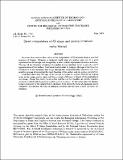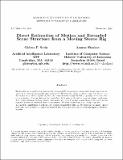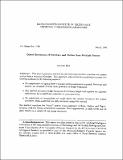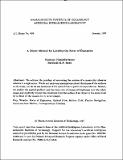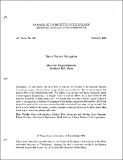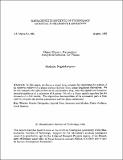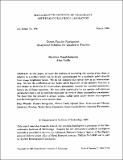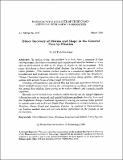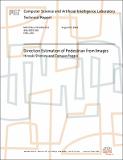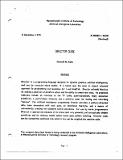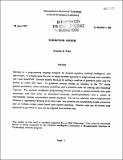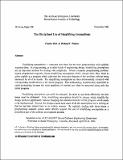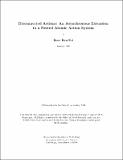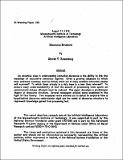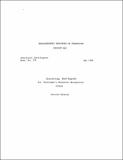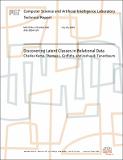Browsing Computer Science and Artificial Intelligence Lab (CSAIL) by Title
Now showing items 939-958 of 3804
-
Direct Computation of 3D Shape Invariants and the Focus of Expansion
(1989-05-01)Structure from motion often refers to the computation of 3D structure from a matched sequence of images. However, a depth map of a surface is difficult to compute and may not be a good representation for storage and ... -
Direct Estimation of Motion and Extended Scene Structure from a Moving Stereo Rig
(1998-12-01)We describe a new method for motion estimation and 3D reconstruction from stereo image sequences obtained by a stereo rig moving through a rigid world. We show that given two stereo pairs one can compute the motion of the ... -
Direct Estimation of Structure and Motion from Multiple Frames
(1990-03-01)This paper presents a method for the estimation of scene structure and camera motion from a sequence of images. This approach is fundamentally new. No computation of optical flow or feature correspondences is required. ... -
A Direct Method for Locating the Focus of Expansion
(1987-01-01)We address the problem of recovering the motion of a monocular observer relative to a rigid scene. We do not make any assumptions about the shapes of the surfaces in the scene, nor do we use estimates of the optical ... -
Direct Methods for Estimation of Structure and Motion from Three Views
(1996-12-01)We describe a new direct method for estimating structure and motion from image intensities of multiple views. We extend the direct methods of Horn- and-Weldon to three views. Adding the third view enables us to solve ... -
Direct Object Recognition Using No Higher Than Second or Third Order Statistics of the Image
(1995-12-01)Novel algorithms for object recognition are described that directly recover the transformations relating the image to its model. Unlike methods fitting the typical conventional framework, these new methods do not ... -
Direct Passive Navigation
(1985-02-01)In this paper, we show how to recover the motion of an observer relative to a planar surface directly from image brightness derivatives. We do not compute the optical flow as an intermediate step. We derive a set of ... -
Direct Passive Navigation: Analytical Solution for Planes
(1985-08-01)In this paper, we derive a closed form solution for recovering the motion of an observer relative to a planar surface directly from image brightness derivatives. We do not compute the optical flow as an intermediate ... -
Direct Passive Navigation: Analytical Solution for Quadratic Patches
(1986-03-01)In this paper, we solve the problem of recovering the motion of an observer relative to a surface which can be locally approximated by a quadratic patch directly from image brightness values. We do not compute the ... -
Direct Recovery of Motion and Shape in the General Case by Fixation
(1990-03-01)This work introduces a direct method called FIXATION for solving the general motion vision problem. This Fixation method results in a constraint equation between translational and rotational velocities that in combination ... -
Direction Estimation of Pedestrian from Images
(2003-08-27)The capability of estimating the walking direction of people would be useful in many applications such as those involving autonomous cars and robots.We introduce an approach for estimating the walking direction of people ... -
Direction Estimation of Pedestrian from Images
(2003-08-27)The capability of estimating the walking direction of people would be useful in many applications such as those involving autonomous cars and robots. We introduce an approach for estimating the walking direction of people ... -
Directional Selectivity and Its Use in Early Visual Processing
(1979-06-01)The construction of directionally selective units and their use in the processing of visual motion are considered. -
Director Guide
(1979-12-01)Director is a programming language designed for dynamic graphics, artificial intelligence, and use by computer-naﶥ people. It is based upon the actor or object oriented approach to programming and resembles Act 1 ... -
Director Guide
(1978-06-01)Director is a programming language designed for dynamic graphics, artificial intelligence, and naﶥ users. It is based upon the actor or object oriented approach to programming and resembles Act 1 and SmallTalk. ... -
The Disciplined Use of Simplifying Assumptions
(MIT Artificial Intelligence Laboratory, 1981-12)Simplifying assumptions — everyone uses them but no one's programming tool explicitly supports them. In programming, as in other kinds of engineering design, simplifying assumptions are an important method for dealing with ... -
Disconnected Actions: An Asynchronous Extensions to a Nested Atomic Action System
(1990-01)Nested transactions, a generalization of atomic transactions, provide a uniform mechanism for coping with failures and obtaining concurrency within an action. -
Discourse Structure
(MIT Artificial Intelligence Laboratory, 1976-08-17)An essential step in understanding connected discourse is the ability to link the meanings of successive sentences together. Given a growing database to which new sentence meanings must be linked, which out of many possible ... -
Discovering Good Regions for Teitelman's Character Recognition Scheme
(1969-05-01)Warren Teitelman presented a novel scheme for real time character recognition in his master's thesis submitted in June of 1963. A rectangle, in which a character is to be drawn, is divided into two parts, one shaded ... -
Discovering Latent Classes in Relational Data
(2004-07-22)We present a framework for learning abstract relational knowledge with the aimof explaining how people acquire intuitive theories of physical, biological, orsocial systems. Our approach is based on a generative relational ...

